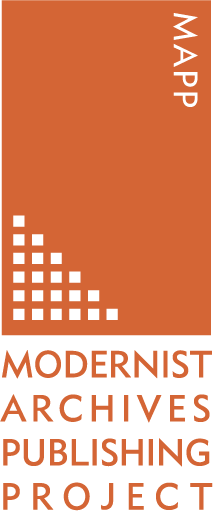As we look to expand the transatlantic dimensions of the MAPP database over the next three years with new materials from American publishing archives, I’ve been assessing the evidence we have currently in the database regarding the Woolfs’ correspondence with American publishing houses.
The Hogarth Press worked with various publishers to produce American editions of Hogarth Press texts. The American book-market (then as now) was an important source of income to British authors and publishers, and the potential sale of English-language book and magazine rights to the States is a significant part of author/publisher correspondence. Early C20 American readers were generally more likely to buy rather than borrow new books (unlike British audiences), and British publishers were keen to tap into the sales potential of the much larger American reading public.
For the Woolfs, operating in America meant bigger sales and greater renown and the securing of their fledgling brand and reputation in a global publishing environment. If the Hogarth Press were successful in selling American rights, it meant tapping into a larger, more lucrative reading market. The earnings from Virginia Woolf’s own books in America - where she consistently earned more than in Britain - was substantial, as Leonard points out in his autobiography, and made a huge material impact on their lives (Downhill All The Way, 145).
From 1921, when Harcourt, Brace (established 1919) published the American edition of Virginia’s Monday or Tuesday, it was the publisher of choice for the Woolfs’ own works. Leonard and Virginia became good friends with director Donald Brace, and generally offered the work of Hogarth Press authors up to him first. In a letter from Leonard to Donald Brace in July 1925 for instance regarding Brace’s offer for the American rights of William Plomer’s Turbott Wolfe, Leonard asks about the American sales of Mrs Dalloway, The Common Reader and Eliza Fay’s Original Letters from India (1779-1815). They were also bringing out Leonard’s Village in the Jungle that same year.
But Harcourt, Brace turned down many Hogarth Press authors, and the correspondence in the Hogarth Press book files at Reading shows the variety of American publishers the Woolfs then turned to. This includes Boni & Liveright (1917-33); Sheed & Ward (1933-73); Doubleday (1897-2009); Putnam’s (1838-1993); Thomas Seltzer (1919-25); and Alfred A. Knopf, Inc. (1915-60).
In fact, some of the earliest surviving correspondence of the Hogarth Press concerns the business of American book rights. An early letter of 8th July 1922 (from the D. H. Lawrence collection in the Harry Ransom Collections) shows Leonard writing to Lawrence’s literary agent, Robert Mountsier, concerning costs for the American rights of Dostoevsky’s Stavrogin’s Confession, published by the Hogarth Press in 1922. And in a long chain of letters with E. M. Forster in the summer of that same year, Leonard sets out his typical policy regarding authors’ English-language book rights, asking Forster: ‘What about America’? ‘Will you deal with that or shall the Press as your agents, taking as agents commission of 10%?’ The correspondence with Forster on American rights is discussed in more detail in Matt Hannah’s blog on Pharos and Pharillion (Matt worked on the metadata for this file).
The correspondence to-and-fro between the Hogarth Press and American publishers over Forster’s Pharos and Pharillion is not unusual. This book was rejected by Harcourt, Brace and Putnam’s, but Leonard had better luck with Knopf. The Knopfs’ publishing house, founded in New York in 1915 and run by a husband-and-wife team who, like the Woolfs, were responsible for bringing Russian and European writers to English-language audiences on either side of the Atlantic, bears lots of similarities to the modus operandi of the Hogarth Press. This relationship is one we want to unpick more through this new grant. Woolf describes meeting Blanche Knopf - like her, a dynamic female publisher, operating in a coterie male world - on one of Blanche’s visits to London in 1931.
There are some fascinating letters in MAPP from the early 1930s signed by the socialist writer Raymond Postage, who acted as the Knopfs’ European representative in their London office in Bloomsbury (opened in 1926). Postgate would go on to be an author with the Hogarth Press after the Knopfs’ London office closed down in 1932, with How to Make a Revolution (1934) and What to do with the BBC (Day to Day Pamphlets, no. 28, 1935).
Discussing the American rights and terms for John Hampson’s Saturday Night at the Greyhound for instance, Postgate sticks with his suggestion of ‘a royalty of 10% up to 5000 copies, and 15% thereafter’ rebuffing Leonard’s request to go higher. Postgate points to the higher production costs in America - this due partly to the power of the American printing and typographic unions - and states that taking a chance on an unknown British author (with a rather dark text) was an experiment on their part: ‘Some day, Hampson, I hope, will be a big seller. But if this is to be so, it will be partly our doing. It really is to his interest to let us have a chance and not press too hard at the beginning’.
We might be surprised by how long the Hogarth Press continued to ‘act as de facto literary agents’ for some of their authors when it came to the US rights market (Battershill and Southworth, 388). But this was a time when the power of literary agents was still in flux, and authors did not always use them.
Where Hogarth Press authors did conduct their business through agents, we see the publisher’s unease in working with a third party. There are some fascinating power struggles over Vita Sackville-West’s The Edwardians, for instance, when her agent, Curtis Brown, gives the right to sell in Canada to the US publisher of The Edwardians, Doubleday Doran. As part of the so-called ‘Empire markets’, Canada would normally, as Leonard points out, be included in the English-language rights secured by the Hogarth Press. Like other British publishers of the time, the Hogarth Press benefited from being able to buy English-language book rights for ‘England, its Colonies and Dependencies’, giving them access to huge Anglophone reading markets across the globe. British publishers would continue to fight for this dominance into the 1970s, well beyond the ‘collapse’ of Empire (Wilson, 29).
We can’t yet do the kind of large-scale quantitative bibliographic work this naturally leads us to. What proportion of Hogarth Press texts did Harcourt, Brace actually publish? How many went to the Knopfs? Which texts went to other American publishers, and why? But we are prioritising some of this work in Stage 2 by including series of letters between publishers like Harcourt, Brace; Knopf; and the William A. Bradley literary agency available via our new partners. An expanded, comparative MAPP database should help answer some of these questions.
The AHRC UK-US New Directions in Digital Scholarship for Cultural Institutions grant (2021-24) enables us to work with a larger group of partners (Harry Ransom Center at the University of Texas at Austin; New York Public Library; Washington State University Pullman; University of Reading Special Collections; and Sussex University Collections) to expand the comparative and transatlantic dimensions of the MAPP database. With this funding, we will create new data and integrate publishing records into our existing dataset from the Knopf archive; Harcourt, Brace; Nancy Cunard’s Hours Press, the Sylvia Beach papers; Chatto & Windus; Allen and Unwin; and the William A. Bradley literary agency.
Battershill and Southworth, 'Woolf, The Hogarth Press and Global Print Culture', in A Companion to Virginia Woolf, ed. Jessica Berman (Wiley Blackwell, 2016).
Wilson, 'British Publishers and Colonial Editions', in The Book World: Selling and Distributing British Literature, 1900-1940, ed. Nicola Wilson (Brill, 2016)
Woolf, Downhill All the Way: An Autobiography of the Years 1919 to 1939 (Hogarth Press, 1968)




